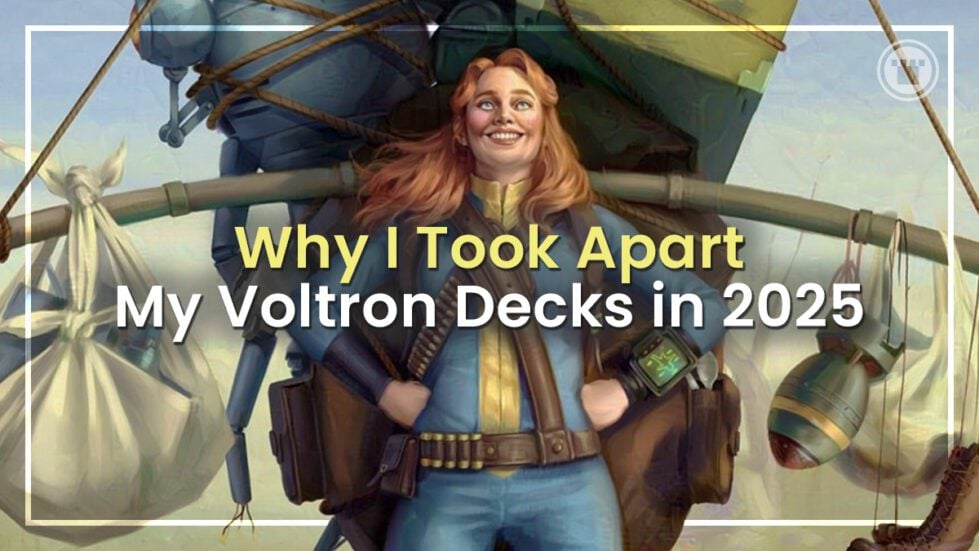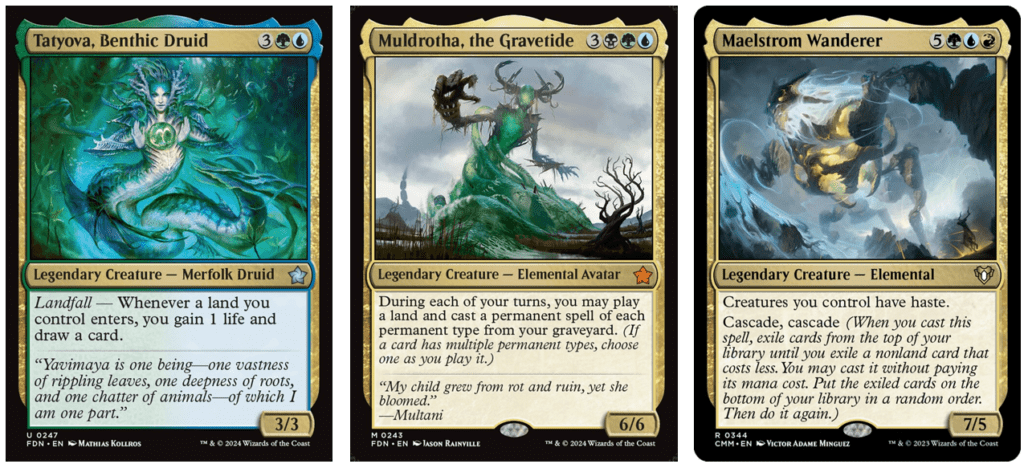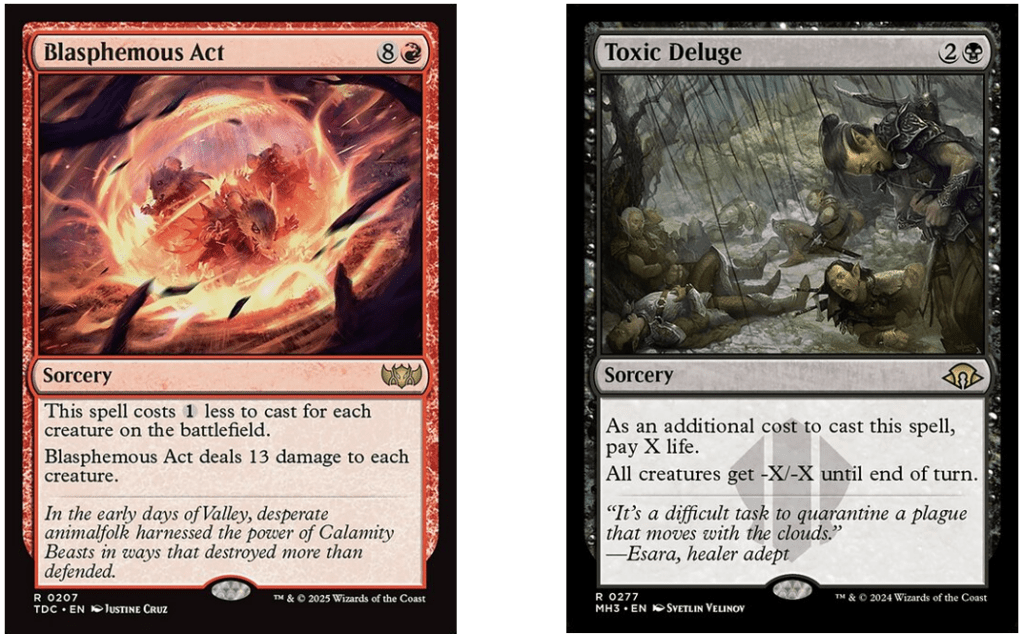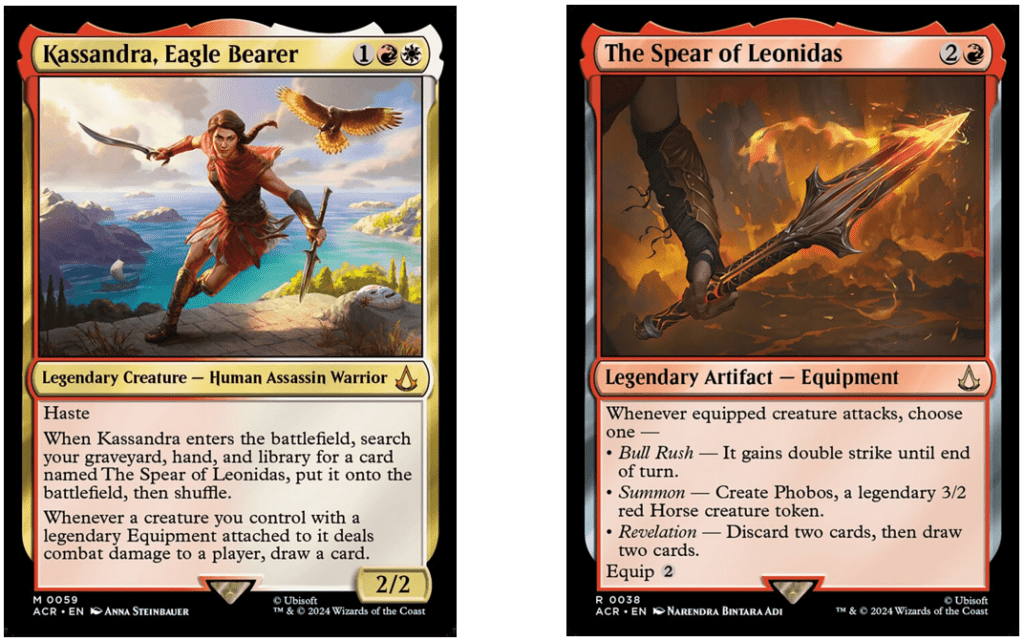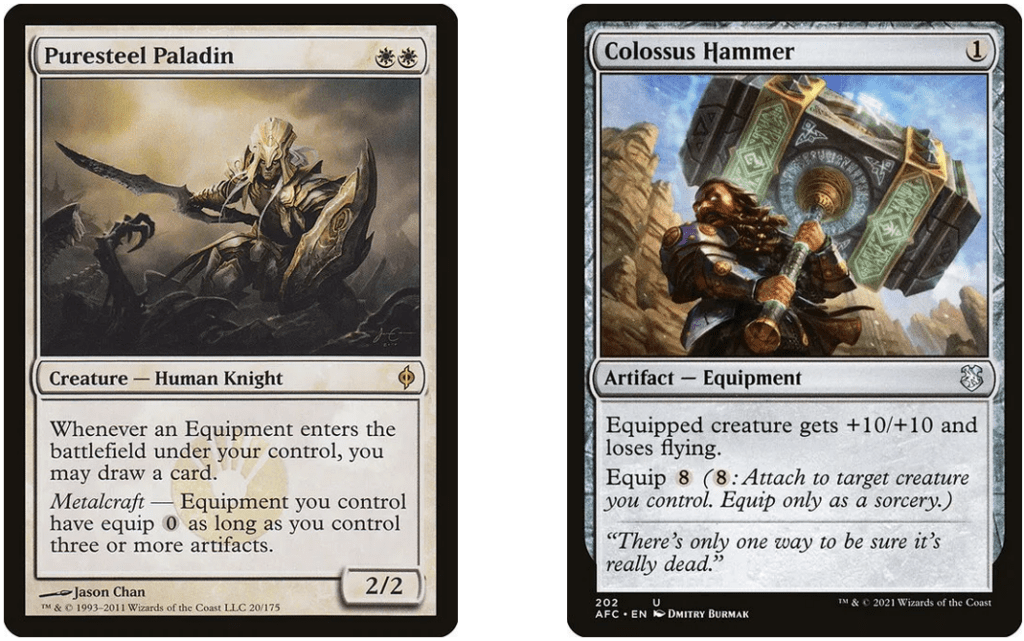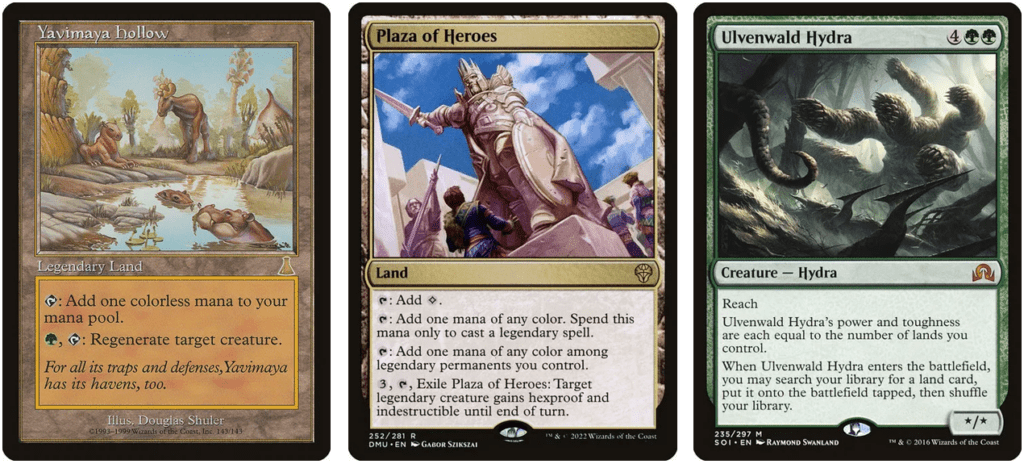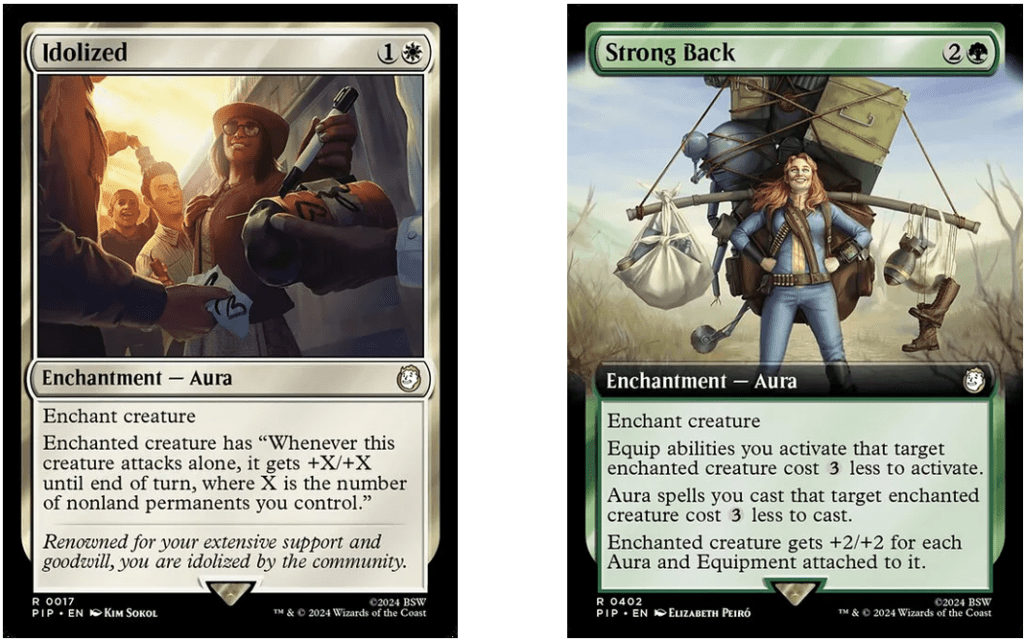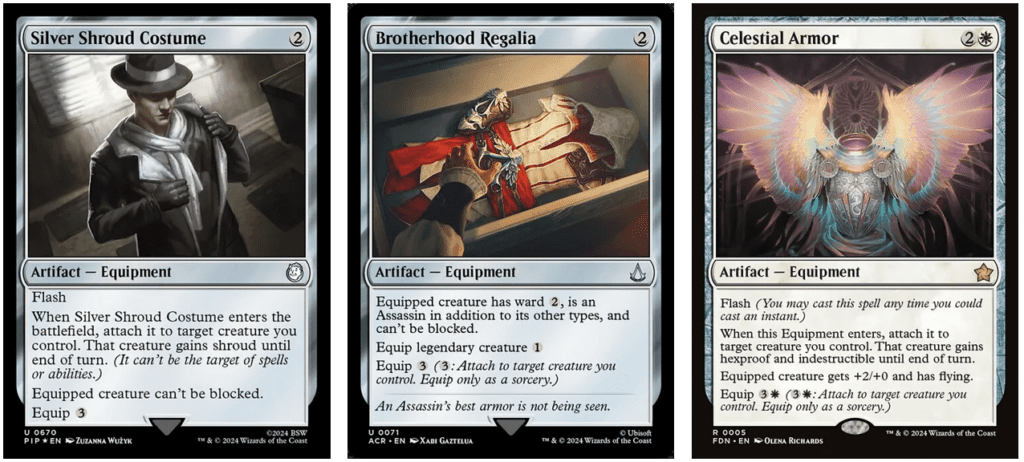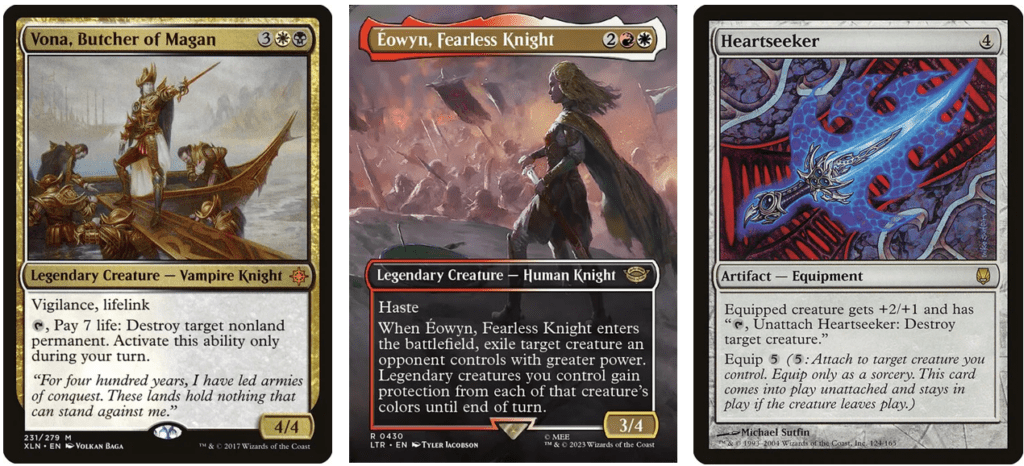Voltron is my favorite archetype in Commander. I love nothing more than strapping up a heroic creature with auras and equipments. But I’ve just retired my three favorite Voltron decks. Why deconstruct them? Sharpen your blade and join me on the frontlines as I talk about why Voltron is taking over Bracket 3 thanks to increasingly powerful staples.
I STARTED PLAYING MAGIC WITH EQUIPMENT
Well, not entirely. My first Commander deck was the Atraxa, Praetors’ Voice deck my friend got me for Christmas one year. That said, the first deck I built from scratch was Aurelia, the Warleader, and I jammed a bunch of Angels and Equipment in it.
Over the years, I progressed to running Aurelia as a full equipment strategy, and to running other Commanders like Akiri, Line–Slinger & Bruse Tarl, or Syr Gwyn, Hero of Ashvale. I tried out an enchantress build with everyone’s favorite Geist of Saint Traft, before moving to Sigarda, Host of Herons.
What drew me to Voltron initially was the flavor. Swords are cool; I have a few myself. It might also have been the fact I previously played Pokemon TCG competitively, building stacked out Pokemon with Energy and Tools, and swinging in with them.
The other thing I really enjoyed though was the underdog gameplay.
VOLTRON MAKES FOR COMPELLING GAMEPLAY
Voltron was fun because I always felt like the underdog. Back when I learned the ropes, you almost certainly knew your first few creatures would be swept away in the tide of a Wrath of God. I had to balance investing creatures and mana into ramping with my Sword of the Animist or drawing cards with Mask of Memory, often grabbing them off of Stoneforge Mystic. We didn’t have all of the redundant setup pieces decks have today. Sram, Puresteel Paladin… that was largely it.
You also couldn’t kill people too quickly, because the remaining two players would have enough resources to stone-age you repeatedly until you ran out of cards. It was necessary to build momentum, but not to strike too soon. The balance had to remain.
Part of the journey of winning with Voltron involved finding the right pieces. You had to find evasion, like Flying or Trample (or Trailblazer’s Boots!). You had to find a way to buff damage high enough to kill in two to three hits (Blackblade Reforged was a huge pickup back in the day!), you had to find Protection and Haste for your Commander as it was definitely going to be removed 3 or more times in a game, and you had to do this with comparatively limited access to card draw and ramp, at least compared to today, and at least if you weren’t playing Rafiq or someone else with green and blue.
Oh, and not to mention the need for recursion. You were gonna be Vandalblasted or Austere Commanded, or even just picked off bit by bit by a rogue Reclamation Sage. Sculpting your hand without access to oodles of card draw was tough, but honestly? Rewarding as hell.
VOLTRON GAMERS WERE FORGED IN THE FIRE
To play Voltron into a sea of Simic “bullshit” was a brave act. It was way more of a wild west out there before pre-game chats found momentum in the past 5 years, and Brackets were but a twinkle on the horizon. You had to be great at reading the table and knowing who might try to combo – or just loop a Constant Mists or Spore Frog.
Many of us resorted to dirty tricks to gain tempo. Rule of Law effects, combos (Adarkar Valkyrie and a sacrifice outlet featured in many Aurelia equipment builds I’ll tell you that much)… I even built a Voltron deck that used mana rocks and Winter Orb at one point. There just wasn’t enough access to draw and ramp, or enough good Commanders low on the curve that were also impactful.
Essentially, Voltron players who started playing before Throne of Eldraine opened the floodgates had to learn how to fight with their bare hands, with grit, and with the last of their wit as their kingdom fell around them. We had to be John friggin’ Wick, and we had to lock in.
There were ways to make the ordeal easier, though. I picked Sigarda, Host of Herons for my Enchantress Voltron deck because she is very, very “sticky”. Syr Gwyn was picked so that I could reduce equip costs, draw cards, and use Sunforger to protect my investments. Heck, at one point, I used the black to play Vampiric Tutor to up my consistency.
THE METAGAME HAS CHANGED
The thing is, things changed. Where before I had to grind to survive off the back of repeated wraths and single-target removal, I now see on average one wrath a game not cast by myself – two if we’re generous. Creatures in general are must-answer problems, and so the threat level of you dropping a Voltron attacker that you might have protection for later just doesn’t register anymore.
And then there’s the power creep. Wow, we got a lot of new toys in the past few years. Part of that is how Equipment is so intrinsically linked to Universes Beyond, a big escalator of both powerful designs but also the sheer amount of them, so often.
Reading my article on how equipment is getting a bit “too good” will shed more light on the reasons behind it, but let’s put it in simple terms:
Handing battle-scarred Voltron players the equivalent of space-age weaponry when they honed their skills in hand-to-hand combat is dangerous. There’s a reason John Wick manages to get out of every scuffle even when he’s out of ammunition. And now you’re handing us this much power? It’s not going to end well.
WHY I RETIRED KASSANDRA
I love Kassandra. I put over 200 hours into Assasin’s Creed Odyssey. I love Boros, and Voltron. But Kassandra in Commander? She’s way too strong for me to be trusted within the command zone.
Never give me this much card draw. It’s dangerous. Don’t give me double strike so easily, either. Is Kassandra a lot fairer without access to the library of Voltron cards, past and present? Yeah, she is. But where’s the fun in that? I’d quite like to run my favorites and old reliables, thanks. I don’t want to have to force myself to make her into a Bracket 2 theme deck to reign her in.
The thing is, though, she’s really good.
I spoke the other week about how it’s possible to put together a bunch of different Kassandra lines that result in a kill on Turn 3-5, and a player kill that early tends to rub people up the wrong way, even if they know what’s potentially coming.
Ultimately, she’s back on the workbench, as I don’t really know what I want to do with her to make her a satisfying deck. Maybe she’s just better in the 99, at least for me?
The question remains; is she Bracket 3, or Bracket 4? I think she can play comfortably in both, but it really does depend on my opponents and their Commanders. I kinda feel like that oft-spoken of Bracket 3.5 is staring at me from across the room, and I’m not ready to invite that part of the discussion in yet – so let’s move to another deck.
WHY I RETIRED SIGARDA
Sigarda, on the other hand, always had access to way more card draw, being in green. Sure, we got Sythis, and Season of Gathering… but we always had the other Enchantress cards, and Hunter’s Insight, Rishkar’s Expertise et al.
The thing with Sigarda these days is that she’s benefited immensely from the slowdown in wrath usage. She also gets around edicts, while being untargetable in most scenarios. That means that our other protection – top tier as it is, being in GW – goes that much further.
The deck packs protection even in the manabase, with Ulvenwald Hydra being a great blocker that goes to find the pieces. Nine games out of ten, I don’t even need this redundancy. 5 years ago? I absolutely did.
And it’s not just the fact she’s more of an “Ice Road Truck” than ever before. I’ve added more hand refills, and more power boosts. When your Commander already has evasion and hexproof, and Wizards keeps printing more cards that do more than one thing, you naturally find that your initial extra deck “space” feels even wider. Just look at Idolized and Strong Back. It’s redundant for the best effects the deck needs. Heck, Strength of the Harvest gave us one in the manabase.
Most games I play with Sigarda inevitably feel unearned these days, and part of that is the tables I’m playing at. As an aside, if there’s one takeaway from this article, it’s that you should definitely adjust your own playstyle and deckbuilding to your meta, as it provides you with way more enjoyment.
Is she a Bracket 4 deck? No, not at all. She lacks tutors, and she’s five mana, and has no combos. Is she Bracket 3? Again, not quite. She’s definitely at the top end of it, and if there was a Bracket 3.5 she’d likely live there.
There’s a strong case to be made that this speaks to Bracket 3 being too broad, but let’s talk more about how the environment contributes.
VOLTRON, POWER CREEP, AND SOCIAL CONTRACT
It’s undeniable that Voltron decks have gotten a lot stronger. Part of that is that they’re consolidating effects on singular cards. Protection can often sit wasted in hand, for instance, and so combining it with Evasion? I mean, why not, eh?
It’s also easier to get that OHKO than ever before, with effects like Excalibur helping get you into double strike range. We know the decks are better, but what about the playing field?
Well for starters, the Top Commanders all encourage curving out. So too do most of the new Commanders printed. They encourage being all-in on your Commander. This puts people off from wrathing, as it feels bad to undo your progress.
A big part of why that is is that cards are more often multiplicative, not additive, these days. If you miss having them for a turn you’re losing way more tempo, as cards tend to synergize in such a way that they accrue you immense resource boosts when used together. Why wrath the board and lose out on your curve-topping, face-melting synergy?
This leaves Voltron as a natural counter to decks who spend their time setting up. If they’re not deploying blockers or running enough wraths, you can essentially kneecap them before they know what’s happening. What’s more, Voltron decks are poised to exploit chinks in the armor. New-era decks tend to dump their hand out onto the board with disregard for the likelihood of being blown out by a wrath. They’re almost too comfortable, and that’s what leads to shattered expectations and disgruntled disbelief when someone puts the pressure on. As I always say, if doing your “thing” is going to win you the game, you should expect people to stop you.
I’m a firm believer that the Commander format is more fun when you have a range of interactive decks instead of a slurry of tap-out midrange soups, but it does at times feel like we’re swimming against the tide. This is especially the case when giving players – like Voltron players, whose deckbuilding and gameplay skills were forged in the fires of greater resistance with fewer tools – a steady stream of power crept weapons and support cards.
The scrappy Voltron player learned to make do with suboptimal tools, and has a greater grasp of the ebbs and flows of a game. They know exactly when to strike, and when to put down players before things get out of hand. When you take away the gas of a new-school Commander player, and leave them in a room with John Wick? Well, I know where I’m putting my money.
BONUS: WHAT HAPPENED TO SYR GWYN?
My other Voltron deck that you might know me for is Syr Gwyn, Hero of Ashvale, a deck I’ve had consistent fun with since 2019. Syr Gwyn is a Voltron deck, yes, but remember that John Wick analogy? It’s also a control deck, and it leverages the pressure of taking away opponent’s resources to back them up against the wall.
It spends the early game accruing mana, before throwing down knights like Vona, Eowyn and Cavalier of Dawn to head off emergent threats, before following up with equipment like Argentum Armor, Sunforger, and Heartseeker – which with Equip Knight – (0), is pretty dang good.
As a Sunforger deck, it also gets to enjoy running the very best spells in Mardu. Heck, it just picked up Inevitable Defeat before I retired it.
Piloting Sunforger with free equips on Gwyn and other Knights at a baseline, alongside Sword of Wealth and Power and a cheeky Reconstruct History, the deck was able to weather every storm and have an answer for anything, even without access to Teferi’s Protection – an intentional choice I made to “power it down”, long before the Brackets system arrived and asked me to do the same by making it a Game Changer.
This deck wasn’t deconstructed for the exact same reasons as the former two Voltron decks, but more just because, like Voltron in general, Sunforger ages like a fine wine. I’d mastered it and done everything I wanted to. Those neurons were just not getting excited anymore when I felt unassailable in most Bracket 3 games. And let me tell you – Gwyn is far from Bracket 4.
END STEP
Playing Voltron used to be about managing the vibes at the table. It used to be a puzzle – trying to find the right pieces in the right order, building a “house of cards”, and hoping you pivoted to eliminating players at the right time. It was as much about not knocking one player out “too early” as it was about winning. It was very much a goldilocks zone kind of deck, and threading that needle was a lot of what made it fun in the first place.
These days, it very much feels like you’re playing judge, jury and executioner. You’re saying “No” in a way not unlike a control mage brandishing counterspells and removal. But instead of interacting on the stack, you’re interacting with your opponents using a stack (of sharp implements). You’re opting for player removal before things get out of hand.
It’s a worthwhile strategy, and one that is mostly fair. I’d go as far as to say that in an era of scant board wipes, Voltron exists as a check and balance against curving out with value generation. It puts pressure on people to do something other than add to their board and draw more cards.
The problem is, more than ever, the newer generation of Commander player wants to play Commander for escapism. They don’t want to think too hard, or bring 5 years of Draft experience into threat assessment and resource management. They want to draw cards and “do the thing”. Modern-day Commander is closer to a “eurogame” (a class of tabletop games that generally feature indirect player interaction, lack player elimination, and provide multiple ways to score points) than a multiplayer game of Magic, and that has never been more true than it is in 2025.
So, where does Voltron go from here? Where do I get my kicks now? Well, in my eyes, there’s two main choices. Either I opt for a Commander that doesn’t provide an insane card advantage (Kassandra) or is too hard to interact with (Sigarda), or I power down the actual tools I’m working with.
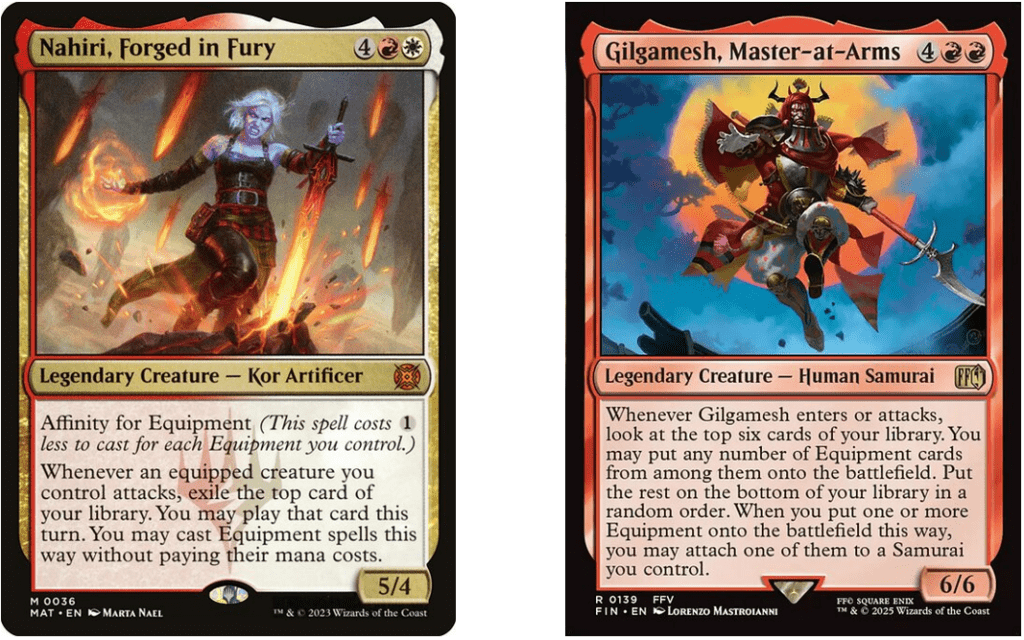
I think adding variance, playing mono-color, or otherwise restricting yourself to running a lot of a particular type of card (living weapon adjacent effects) might provide you the ideal Bracket 2 or 3 experience if you’re experiencing a similar quandary.
If we ever do slot in another bracket (something I’m in favor of), or change the parameters, you can bet I’ll be spinning up Sigarda and Kassandra for that Bracket 3.5 again. In the meantime, I play way more B2 and B3 games, and I’d like to play my favorite strategy and not absolutely crush tables – so it’s back to the drawing board for me at least.
Either way, it does seem like Voltron and other forms of fast aggro might be emerging as the better decks in the average Bracket 3 kind of game. 2018 Kristen would never believe it.
—————-
If you are in the market for some stronger lists, then you can find my Voltron decks below:

Kristen is Card Kingdom’s Head Writer and a member of the Commander Format Panel. Formerly a competitive Pokémon TCG grinder, she has been playing Magic since Shadows Over Innistrad, which in her opinion, was a great set to start with. When she’s not taking names with Equipment and Aggro strategies in Commander, she loves to play any form of Limited.

